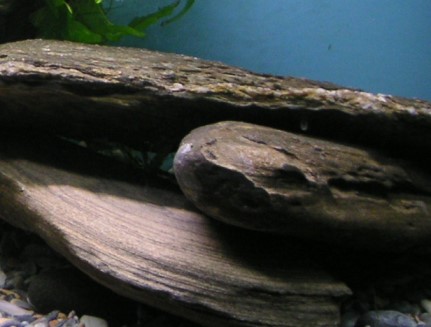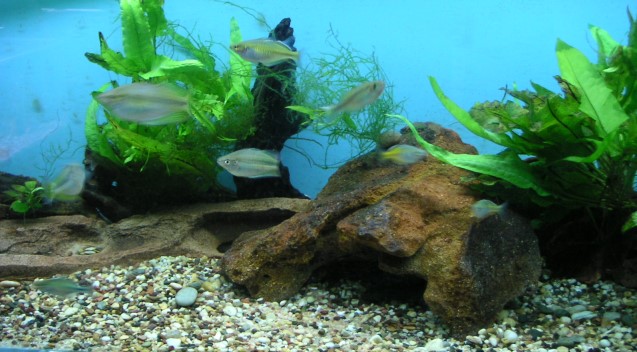| ROCKS USED IN AQUARIA
ROCK TYPES Igneous Rocks are those that formed from molten material (magma) either at various depths within the Earth's crust (plutonic rocks such as granite) or at or near its surface (volcanic rocks such as basalt). Igneous rocks that are rich in quartz (SiO2) are termed “acidic”, those with small amounts of quartz are called “intermediate” and those without quartz are termed “basic”. Common acidic rocks include granite, rhyolite, pegmatite and obsidian. Intermediate rocks include syenite, diorite, andesite and trachyte. Basic rocks include gabbro, dolerite and basalt. Many are non-porous and suitable for use in the aquarium. Those with large amounts of flaky mica are not suitable because the mica flakes away and looks unsightly. Weathered igneous rocks may be porous and soak up water and may weather and become spongy, taking up potential pollutants from their environment and releasing them slowly into the aquarium- which is not wanted. Choose water worn specimens or fresh rocks that have no sharp edges and are not very porous. Do not use igneous rocks that are highly mineralised with iron or other minerals, otherwise you risk alteration of the water chemistry over time, as the minerals leach into the water. Igneous rocks are decorative, generally inert but offer no other useful
properties such as helping buffer water chemistry in alkaline
environments. Sandstones are generally inert in water and are useful for decorating aquaria, especially where an acid water parameters are maintained (pH < 7.0). However soft, crumbly rocks such as mudstone, marl, shale and some breccia are not suitable. Some may be porous and release pollutants into water so consult your stockist on the type available. Use only non-porous, quartz based sandstones in freshwater aquaria. Limestone is usually white, grey or brown in colour, depending
upon mineral content. They all contain varying amounts of calcium
carbonate and magnesium carbonate and are useful rocks in aquaria where
alkaline water is maintained, with pH > 7.0. The properties of limestone
corresponds with their formation and some contain shells, coral or
calcareous algae, while others contain calcium carbonate from chemical
activity, as in the case of dolomite, oolite and calcrete. Most limestone
forms from marine deposits and is free of mud and sand, making them ideal
for marine aquaria. Marble and dolomite are related to limestone and are discussed as a
metamorphic rocks. Dolomite forms from compressed depositions of calcium and magnesium carbonate and is hard and non-porous. It varies in colour from near white, brown, grey to black and is used in aquaria where the parameters of hard water, a high pH and good buffering are maintained. For that reason, dolomite is used in alkaline biotypes such as those for cichlids from Lake Malawi and Lake Tanganyika. Its disadvantage is that it is very heavy compared to limestone and has sharp edges when broken. Water worn dolomite gravel makes an excellent substrate in alkaline biotypes and can be used in marine aquaria in place of coral sand and coral rubble. Slate is altered shale or mudstone and is non-porous. It fractures in sheets and can be easily shaped to build rock pile biotypes, provided that the sheets are thick enough not to break. Slate makes good flat surfaces for spawning areas. I do not live far from a slate quarry and pieces can be had in suitable sizes for my tanks and shaped to size- when I need grey rocks. Other metamorphic rocks such as quartzite, schists and gneisses make excellent aquarium rocks, as they do not alter water chemistry. They often contain interesting patterns and larger, mineral masses that are very decorative. REMEMBER Use inert rocks such as sandstone, slate, granite and basalt for water conditions that are soft or low in pH. Use limestone, dolomite or marble for hard water environments and high pH conditions where buffering is required. Clean all rocks thoroughly before use and file rough and sharp edges smooth. Don't use metallic ores. Ensure that only flat surfaces are placed against the glass base and not sharp points that concentrate weight load in a narrow spot. Avoid rock falls and slipping substrate. Never place heavy rocks on top of the substrate but directly onto the base of the tank. In that way you will avoid slips and falls if the substrate moves (fish dig!). Keep any structures safe and unmoveable, using stable stacks or silicone sealant (fungicide free types for aquarium use) to build structures such as caves and terraces. Make them in easily assembled sections that fit together so as not to fall or collapse. Design your bio-scapes well, so that fish have retreats as well as open swimming places. Design will depend on the species kept, as well as upon the choice of rocks available to you.
The picture at the top of this page shows part of a rock-pile biotype constructed of pieces of water worn gneiss and schist. The flat, knotted schist slab makes an ideal surface for spawning and for algae growth. The fish keep it well cleaned. This structure suits Julidochromis sp. and is very stable. Extra stories can be added to the structure as needed and would require cementing with silicone sealant to make it safe as it rises.
Watershed Aquaculture is now closed due to high costs of electricity in Sth Australia.
|
 Will any old rocks do the job?
Will any old rocks do the job? Pictured
left, is a ironstone cave formed of iron-rich sandstone sitting on a
substrate of quartzite gravel. Behind is a sandstone slab, sitting on the
tank base and acting as a terrace divider. The vertical structures are
sandstone and wood on which Java Fern is tied. The tank supports New
Guinea Rainbowfish.
Pictured
left, is a ironstone cave formed of iron-rich sandstone sitting on a
substrate of quartzite gravel. Behind is a sandstone slab, sitting on the
tank base and acting as a terrace divider. The vertical structures are
sandstone and wood on which Java Fern is tied. The tank supports New
Guinea Rainbowfish.